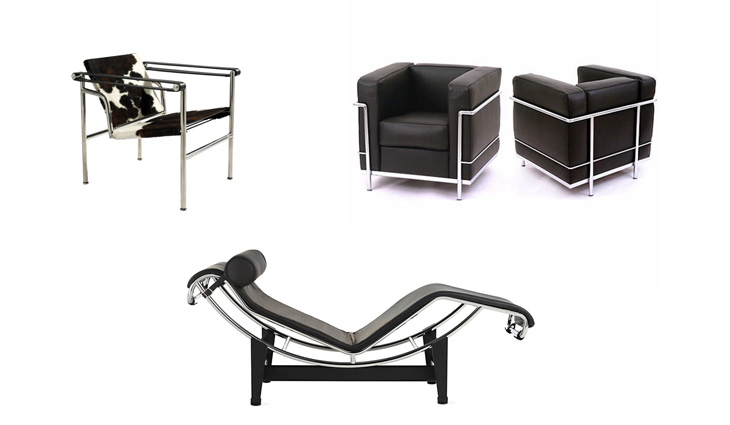The inspirational synergy of Corbusier, Jeanneret & Perriand
- Mehmet Yücebaşoğlu
- Jan 11, 2022
- 4 min read

Architectural works are among the primal elements that change the world and open or close periods in time. Each period has its own characteristic style, details, and materials. Even people without any training in architecture can guess the date or period of a building or a design when they look at the details. If a structure has sash windows, alcoves, asymmetrical forms, curb roofs, and vibrant-colored details, we can safely say that it belongs to the “Victorian” era. If it has arches, courtyards, indoor designs, and grooved surfaces that let the light in, we deduce that it’s an example of Islamic architecture. Perception in architecture or design begins with visuality. In terms of modern architecture, or modernism, which began in the early 20th century and still continues, we see a prioritization of simplicity as the materials of the structure are hidden and there is a use of glass and natural light.

Having taken revolutionary steps and created memorable works that shaped modern architecture, Le Corbusier is regarded among the most influential architects of the 20th century. Besides his interest in architecture, he wrote books, painted, and designed furniture. Charles-Édouard Jeanneret, also known as Le Corbusier, collaborated with his cousin Pierre Jeanneret, who was a renowned architect, and Charlotte Perriand, with whom he originally refused to work but was interested in her “Bar Sous Le Toit” (Bar in the Attic). American office furniture, pieces without any discernible style, and objects that can be described as standardized, functional, and practical - Le Corbusier prefers to adopt the functionality of such objects in the interior of his projects and to reveal aesthetic concerns through this rediscovered functionality. Generally unable to bring his idiosyncratic and modern approach in projects into interior space, Corbusier likens Perriand’s perspective in modern approach in her “Bar Sous Le Toit” to his mindset. The works created by this trio became modern classic furniture which would gain a global reputation with years-long manufacture and use.
Design is a process of creation and development with no limits. It’s hard to work as a team with the same understanding of design. While Corbusier designed the general features of chairs and guided the design process, Perriand and Jeanneret focused on the details, the production, and the essential design. Le Corbusier, Pierre Jeanneret, and Charles-Édouard Jeanneret -each with an assertive personality- achieved an extremely difficult goal. The designs born from this friendship and collaboration carved their names into the world history of design.
From 1927 to 1937, Perriand worked with Le Corbusier and his architect cousin Pierre Jeanneret, which Perriand would later describe as a “privilege.” She mostly focused on seating arrangements, the equipment of a modern residence, and furniture designed by workshops. She was also responsible for prototype manufacture and the final versions of designs. The legendary trio of Le Corbusier, Perriand, and Jeanneret defined a series of standard seating positions and designed the LC furniture series based on them. In 1928, they created three of the century’s most iconic chairs: “Siège à Dossier” (a chair that makes it comfortable to lean back, LC1), “Fauteuil Grand Confort” (an elegant yet comfortable armchair, LC2 and LC3), and “Chaise Longue” (a lounge chair for relaxation, LC4). Enabling various seating positions for maximum comfort, these designs are still manufactured and used in great numbers.
However, due to Le Corbusier’s rising reputation, the designs were associated only with his name. Far from being disturbed by this, Perriand saw it as an opportunity to manufacture these designs in a more extensive and popular way and preferred that the designs became a part of the collective view on modern living rather than gaining a reputation himself. The most distinctive work of their collaboration which finished many projects over the years was “Equipement Intérieur d’une Habitation” with which they reinterpreted the interior space they designed for Salon d’Automne in 1929.
LC series furniture which are mostly described as “iconic furniture designs that made a lasting impression on the century by Le Corbusier.” The adventure of designing furniture, which in fact began when Pierre Jeanneret and Le Corbusier invited Charlotte Perriand to their office, and these three names created numerous designs, each more legendary than the last. However, the series was named “LC” after Le Corbusier’s initials due to his fame.
Pierre Jeanerette and Charlotte Perriand played a major role in Le Corbusier’s career. We cannot know what these three friends who complemented each other experienced in the face of Le Corbusier’s unstoppable fame and ego, but we now know that Le Corbusier didn’t become a brand on his own. In 2019, Fondation Louis Vuitton in Paris held an exhibition titled “Charlotte Perriand - Inventing A New World” in honor of Perriand who remained in the background compared to Corbusier. The exhibition was so popular that they had to extend the dates. The exhibition, which I had the opportunity to visit, displayed the designs of these three great names. It was quite impressive to personally examine the original designs of that period.
The designs of these three friends, who broke new ground by complementing each other especially in furniture designs, continue to inspire the world. Some friendships inspire.





